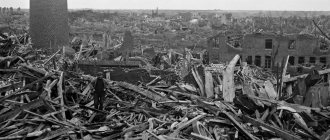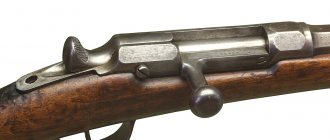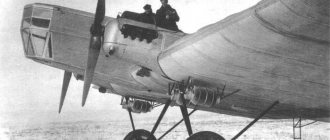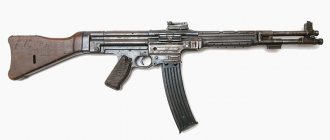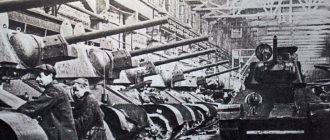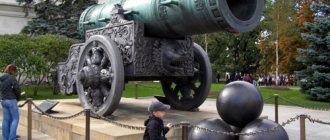On February 11, 1940, the Red Army launched the last major offensive of the Winter War
The operation to break through the so-called “Mannerheim Line” - a key element of the Finnish defense during the Winter War of 1939-40 - became a turning point in the fighting. Just a month after, on February 11, after a long and large-scale artillery barrage, Soviet troops managed to break into the Finnish defenses, the Republic of Finland turned to the USSR with a proposal to end the war and begin peace negotiations.
Soviet 203-mm howitzer B-4 in a firing position on the Karelian Isthmus. Put forward for direct fire, such large-caliber guns played an important role in breaking through the “Mannerheim Line”
Source: waralbum.ru
Protracted lightning war
The Soviet-Finnish War of 1939-1940 is called both the Winter War and the Third Soviet-Finnish War - after the war of 1918-1920 and the war of 1921-1922. The offensive of the Soviet troops, which began on November 30, quickly stalled: the intelligence data collected on the eve of the war about the system and nature of the Finnish defense turned out to be very far from reality. The training of the Soviet troops also turned out to be low, whose skills did not correspond to the realities of warfare in the winter conditions of the Karelian Isthmus and North Karelia. Therefore, just two weeks later, by December 12, 1939, the advance of the Red Army was stopped in almost all sectors of the front stretching from the Baltic to the White Seas, and shortly before the New Year the front stabilized along its entire length.
The stubborn resistance of Finnish troops, reinforced by foreign volunteers, the large-scale use of snipers and anti-personnel mining by the enemy, the competent use of reserves - all these factors turned out to be a big surprise for the command of the Red Army. Conceived as a lightning-fast operation to advance deep into enemy territory with the subsequent establishment of a pro-Soviet government in Finland, the Winter War threatened to drag on for a long time, which brought the USSR not only military and material, but also significant political losses. By that time, the country had already been expelled from the League of Nations for starting an aggressive war, but this could not be the last unpleasant foreign policy event. It was necessary to turn the tide of hostilities as quickly as possible and ensure that the Red Army, significantly superior to the enemy in numbers and combat capabilities, was able to break through the Finnish defenses and force the government of the Finnish Republic to move on to peace negotiations.
T-28 tanks of the 20th heavy tank brigade before entering a combat operation. Karelian Isthmus, February 1940
Source: waralbum.ru
Mannerheim Line or Enckel Line?
The line of defensive structures on the Karelian Isthmus received the name of Mannerheim, the Finnish commander-in-chief, and then the President of Finland, only at the end of 1939, when a group of foreign journalists visited its construction. The journalists returned home and wrote a series of reports about what they saw, in which they mentioned the term that later became official.
In Finland itself, this defense complex was long called the “Enkel Line” in honor of the chief of the General Staff of the young republic, who in the early 20s of the 20th century paid great attention to the construction of defensive structures on the southern borders of his homeland. Construction of the line began in 1920 and was suspended in 1924 when Enckel resigned from his post.
It resumed only in 1932, when the legendary military leader Carl Gustav Mannerheim, who a year earlier became the head of the State Defense Committee, toured the “Enkel Line” with an inspection and gave the order to complete its construction, strengthen and modernize it.
Large reconnaissance in force
The most prepared for defense against the Red Army was the so-called “Mannerheim Line”. It covered the narrowest and most dangerous section of the Soviet-Finnish border - from the shore of the Gulf of Finland to the shore of Lake Ladoga. It was here that the most combat-ready Soviet formations were concentrated, and it was here that the intensity of the fighting was the fiercest. But the Red Army soldiers failed to achieve success in the first battles: the troops advanced several kilometers and came up against the first and main defensive line of the “Mannerheim Line.” It was impossible to break through it on the move, since the Red Army lacked either large-caliber artillery, experienced engineering reconnaissance, or understanding of the tactics of breaking through such fortifications.
But attempts to attack the “Mannerheim Line” throughout December 1939 should not be considered useless. These battles allowed the Red Army command to determine the tactics of the future offensive, learn to coordinate the actions of infantry, artillery and tanks, and appreciate the importance of engineering reconnaissance. The information obtained during the failed offensive about how the Finnish defense was organized on the Karelian Isthmus made it possible to organize training in breakthrough tactics on the ground at the Finnish training ground captured in the first battles. It was based on the large-scale use of artillery - both in the form of massive artillery preparation before a breakthrough, and in the form of direct fire shelling of the most powerful fortifications and firing points from large-caliber guns. Only after this did the infantry go on the attack, accompanied by tanks, which made a breakthrough following the barrage of fire (a few years later, such tactics would become common on the fields of the Great Patriotic War).
Soviet heavy tank T-100 from a special group of heavy tanks on the Karelian Isthmus. On the turret of the tank is Pyotr Voroshilov, the adopted son of People's Commissar of Defense Kliment Voroshilov, a representative of the Red Army Automotive and Tank Directorate at the Kirov plant, which produced the vehicle.
Source: waralbum.ru
The whole of January was spent on preparation, during which the Red Army troops continually made attempts to attack the “Mannerheim Line”, but not with the goal of a breakthrough, but thus continuing to find out more and more details about the organization of the Finnish defense. This continued even in early February, when Soviet troops were ready to launch a large-scale offensive. Some researchers still believe that it really began on February 1, but only ten days later was success achieved. In reality, the day the breakthrough began was February 11, 1940.
What is now the site of the Mannerheim Line?
Immediately after the end of the Winter War, Soviet sappers made considerable efforts to destroy the remnants of the Mannerheim Line. Most of the firing points were blown up, only those engineering structures that could not be dismantled remained intact.
During the Soviet-Finnish War of 1941-1944, the Finns who reoccupied these territories did not want to restore the “Mannerheim Line”, considering this matter to be futile.
Did you like the article? Then support us, click
:
Who was deceived by the artillery?
By this day, serious changes in command had occurred at the front. The North-Western Front, created on January 7, was headed by 1st rank army commander and future People's Commissar of Defense of the USSR Semyon Timoshenko. The main striking force of the front was the 7th Army under the command of 2nd Rank Army Commander Kirill Meretskov (it was rumored that in this way he was given the opportunity to rehabilitate himself after the unsuccessful December battles). The chief of the artillery staff of the 7th Army was brigade commander Leonid Govorov, who was hastily called from Moscow, the future defender of Leningrad, and then a senior teacher of tactics at the Red Army Artillery Academy. And all these changes were made for the sole purpose of concentrating the best military personnel against the Mannerheim Line in order to ensure the success of the new offensive.
Commander of the North-Western Front, Army Commander 1st Rank Semyon Timoshenko
Source: waralbum.ru
It began at 9.40 am on February 11, 1940 with a large-scale artillery preparation unseen since the Battle of Verdun in the First World War. It stretched on some sections of the front for two and a half, and in some places even three hours. Moreover, this was not a banal shelling of squares: over 100 Soviet batteries, including large-caliber ones, fired at strictly designated targets. Moreover, at some point the fire was transferred to the second line of defense, and the Finns, deciding that right now the Soviet troops would go on the attack, rushed to occupy dilapidated pillboxes and trenches. At this moment, the Soviet artillery shifted its fire back, destroying not just the enemy’s fortifications, but mainly his manpower. The effect of this technique was so strong that when the shelling stopped, the Finnish soldiers remained on the second line, deciding that they were again being deceived.
Finland. Mannerheim Line
Mannerheim line diagram.
The Mannerheim Line (Mannerheim-linja) is a defensive structure on the Karelian Isthmus between the Gulf of Finland and Ladoga, built in 1920-1939 to deter possible aggression from the USSR. The line is named after the commander-in-chief of the Finnish armed forces, Marshal Karl Mannerheim. However, the authorship of the defensive line belongs to Lieutenant Colonel A. Rappe, and the construction of the main structures was led by Major General O. Enkel. By order of Mannerheim, only a few fortifications were built to strengthen the defense of individual areas. The name was invented by the marshal's adjutant, which was then spread around the world by foreign journalists.
First tank landing
In many areas, artillery shelling of fortified nodes of the “Mannerheim Line” was carried out from large-caliber guns at direct fire, which had a very strong effect. Concrete and granite fortifications, which could not be taken two months ago, were blown to pieces, and if they continued to be snarled by fire after that, it was only thanks to the desperate courage of the Finnish soldiers. But the job was done: the defenses were breached. Finding itself at the forefront of the breakthrough, the 123rd Infantry Division of the 7th Army, with the support of two tank battalions, managed to take one of the key heights in its sector, and a gradual expansion of the offensive began at this point.
The Red Army commander assesses the thickness of the armor plates of a captured Finnish bunker, February 1940
Source: waralbum.ru
The division commander, Colonel Philip Alyabushev, had to be thanked for this. An experienced officer, he managed to organize reconnaissance in his sector of the front in advance, tirelessly drove his soldiers and commanders to the training ground, and by the beginning of the offensive he had a division prepared in every sense. Its actions were supported by 108 guns concentrated in a narrow area - only three kilometers! - the breakthrough area, and their actions at the moment the offensive began were planned literally minute by minute. And this allowed the formation to break through the “Mannerheim Line” with minimal losses. It is not surprising that the same division was the first to reach the second line of defense of the “Mannerheim Line” on February 17, and four days later completely captured it, for which both the formation itself and its commander were awarded the Order of Lenin. By the way, it was on the orders of Colonel Philip Alyabushev that for the first time in the history of the Red Army, tank landing groups were used, the use of which would later become common practice: infantrymen were placed on armor and thus went into a breakthrough, getting the opportunity to attack the defending Finns from the rear.
Hero of the Soviet Union Lieutenant Mikhail Sipovich (left, in a destroyed observation cap) and Captain Ivan Korovin on a captured Finnish bunker, mid-February 1940
Source: waralbum.ru
Defensive structures - bunkers
The most important containment zone was the defense units, which consisted of several concrete bunkers (long-term firing points), as well as bunkers (wooden-earth firing points), machine gun nests, dugouts and rifle trenches. Along the defense line, strongholds were placed extremely unevenly, and the distance between them sometimes even reached 6-8 km.
As you know, military construction lasted more than one year, so according to the time of construction, bunkers are divided into two generations. The first includes firing points built in the period from 1920 to 1937, and the second - 1938-39. Pillboxes belonging to the first generation are small fortifications designed to install only 1-2 machine guns. They were not sufficiently equipped and did not have shelters for soldiers. The thickness of the concrete walls and ceilings did not exceed 2 m. Later, most of them were modernized.
The second generation includes the so-called millionaires, since their cost cost the Finnish people 1 million Finnish marks each. The Mannerheim Line had only 7 such powerful firing points. The million-dollar bunkers were the most modern reinforced concrete structures at that time, equipped with 4-6 embrasures, of which 1-2 were guns. The Sj-4 “Poppius” and Sj-5 “Millionaire” bunkers were considered the most formidable and the most fortified.
All long-term firing points were carefully disguised with stones and snow, so they were very difficult to detect, and it was almost impossible to penetrate their casemates.

